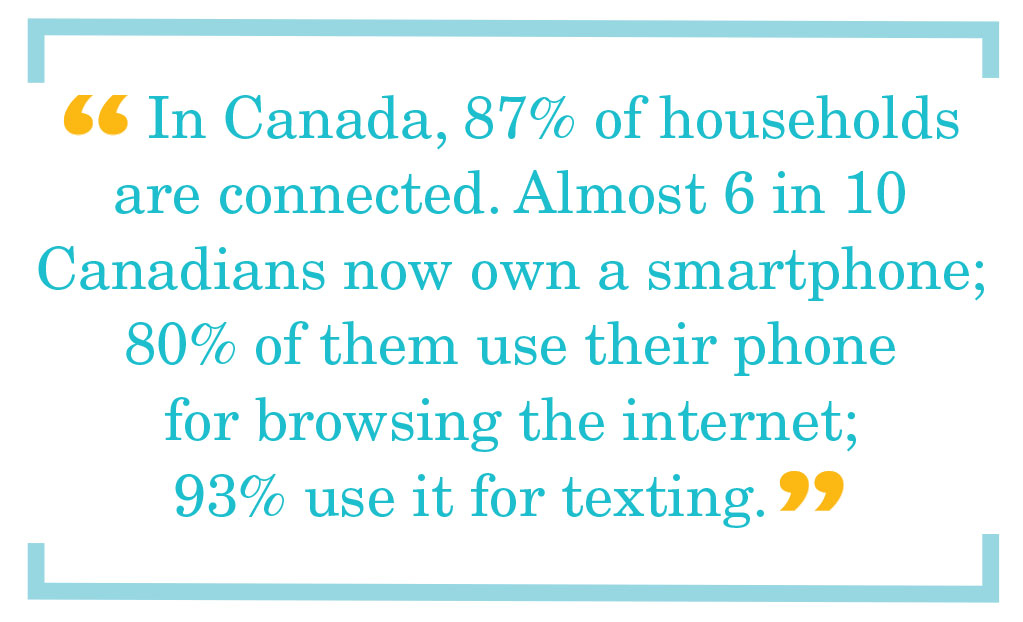For Depression Using Smartphones to Advance Measurement-Based Care
By Vanessa C. Evans, Cindy Woo and Dr. Raymond W. Lam
Major depressive disorder, also known as clinical depression, is currently the world’s leading cause of disability and the second greatest contributor to global burden of disease. In Canada, depression affects one in seven people over the course of their lifetime and costs the economy over $6 billion per year, from direct health care and disability costs as well as indirect costs such as time missed from work and reduced productivity. It is no wonder that improving outcomes for this common and debilitating disorder is a top priority for Canadian health care.
The good news is that depression is a treatable condition. Evidence-based treatments such as psychological therapies and antidepressant medications can return the majority of people with depression to their well selves. The not-so-good news is that many people with depression have poor outcomes because of less-than-adequate follow-up and monitoring of symptom improvement. In particular, people are often not engaged in measurement-based care for depression.
What is measurement-based care?
Measurement-based care for depression refers to the regular and consistent measurement of symptoms to guide treatment decisions. Measuring health status is both essential and routine in most areas of medicine; for example, doctors screen for and monitor hypertension by regularly measuring blood pressure, or adjust medication dosage in diabetes based on hemoglobin A1C levels. In mental health, we do not yet have laboratory tests to assist with diagnosis or to determine the severity of a disorder. However, we have the next best thing: scientifically validated questionnaires and scales that can help provide consistent, accurate and thorough information about mental health symptoms and severity.
Useful tools include the Patient Health Questionnaire (PHQ-9) and the Generalized Anxiety Disorder (GAD-7) questionnaire, both of which are often used by family doctors to screen for and monitor depressive and anxiety conditions. The use of these scales to support measurement-based care in clinical practice has been shown to improve depression outcomes, as they help doctors make more informed decisions about patient progress and treatments.
Despite the evidence showing better outcomes with measurement-based care, many doctors are not using these tools in routine clinical practice. Barriers to implementation include lack of knowledge of which questionnaires to use, difficulty explaining the use of scales to patients, a perception that using scales takes more time, lack of office procedures to track results from questionnaires, and lack of electronic medical record (EMR). Mobile technology may be the tool that helps to overcome some of these barriers.
 How mobile technology can be put to use
How mobile technology can be put to use
Health care has increasingly incorporated electronic and mobile technology, leading to what has been dubbed “eHealth” and “mHealth” care. Mobile technology offers many advantages including more personalized experiences, immediate feedback, convenience, 24/7 availability, and connection to vast networks of people, resources and information.
At the Mood Disorders Centre at the University of British Columbia (UBC), we are particularly interested in mobile technology as an enabler of accessible solutions to mental health care challenges. A simple search on the web or in the iTunes store will find many mental health and depression apps available for smartphones and mobile devices, but most do not use validated measures or evidence-based approaches, nor have they been developed with input from medical professionals.
To address this need, we partnered with UBC’s eHealth Strategy Office to develop MoodFx (pronounced “Mood Effects,” www.moodfx.ca), a mobile-friendly website that allows individuals to actively engage in measurement-based care and work with their health care provider to get the best possible treatment outcomes. We also designed MoodFx with active input from both people living with depression and the clinicians who treat them. Using it, individuals can accomplish the following:
• Screen for symptoms of depression, anxiety and related difficulties with cognition and work functioning.
• Track these symptoms over time, so they can follow progress during treatment.
• Set reminders to check symptoms regularly and before appointments with their doctor.
• Print, e-mail or show their results to their doctors right on their mobile device.
• View their past results and progress over time with the help of simple charts.
• Receive helpful tips for managing depression, anxiety and difficulties with cognition and work stress.
• Monitor for the return of any symptoms once they feel better.
MoodFx is secure, confidential, free and easy to use; it takes less than five minutes to complete an assessment the first time. People who suspect they might be having difficulties with their mental health can self-screen for depression and anxiety, as well as related difficulties with cognition and functioning. After responding to a brief set of questions, which include the PHQ-9 and GAD-7, users immediately receive an easy-to-read report of their results. Their symptom severity is rated in clinically relevant categories from none, mild, moderate, to severe. Because all the questions used in MoodFx derive from validated scales used in clinical practice, the results can be confidently used to inform decisions about diagnosis and treatment.
The program also recommends appropriate next steps based on the individual’s results. For example, if depressive symptoms fall in the mild range, MoodFx suggests that users complete the questionnaires again in a few weeks to see if the symptoms have stayed the same, worsened or improved; this is because mild symptoms are sometimes a normal, transient response to life stress that will resolve naturally in time. In contrast, if symptoms fall in the moderate to severe range, MoodFx encourages users to print the results and show them to their health care provider, such as their family doctor.
How MoodFx helps to treat depression
MoodFx was designed to be helpful to mental health professionals—including family physicians, psychiatrists and psychologists—in their clinical management of patients and clients. It allows consistent assessment to occur outside of valuable clinic time, and empowers patients to become more aware of symptoms and to take an active role in monitoring and improving their well-being.
For individuals with an existing diagnosis of depression, anxiety or another disorder in which these symptoms are likely to co-occur, MoodFx goes beyond screening to allow people to monitor their own symptom outcomes over time. The program displays all their past results in a simple graph chart, so that patients can actively engage in and facilitate their own measurement-based care.
For example, after starting a new treatment, clients can assess their symptoms every two to four weeks and visually monitor their progress. If symptoms are not improving, they can notify their health care provider so the treatment can be re-evaluated and adjusted if needed. We encourage users to show their doctor
their results on their smartphone during the appointment. The results can also be printed out for the doctor’s charts, or scanned into their EMRs.
A common problem with paper-and-pencil mood charting (or even completing questionnaires on a desktop computer) is that it is challenging for someone with depression to remember to complete questionnaires regularly. MoodFx addresses this by allowing users to set reminders (sent by text or e-mail) to check their symptoms at regular intervals and/or before appointments. And, given that mobile devices such as smartphones are almost always with us, it becomes much easier for people to have regular check-ins whenever they have a few moments to spare. This helps to ensure that measurements are up to date.
MoodFx will also be useful to counsellors, social workers, occupational therapists and many other professionals who work with patients and clients with depression. It not only focuses on symptoms, but also assesses functioning, because functional recovery from depression may take longer than symptomatic improvement.
For example, workplace functioning is an important consideration
for people with depression. In Canada, as many as seven out of 10 people with clinical depression are employed, but they often struggle to perform their work duties because of their symptoms. MoodFx includes the Lam Employment Absence and Productivity Scale (LEAPS), a validated self-report measure of work functioning, so that these important functional outcomes can be monitored.
Finally, users can subscribe to receive weekly self-management tips, also by text or by e-mail. These are practical strategies from trusted internet resources that people can use right away to feel better or maintain wellness.
What is in the future?
We plan on regularly updating MoodFx in response to evaluation and user feedback. We also believe that advances in mobile technology will no doubt lead to ever more innovative and powerful solutions: biosensors to detect activity levels, monitor sleep and even measure biological markers of depression; integrated record-keeping and communications with health care providers; and new avenues for social connectedness and peer support. For now, though, we hope that MoodFx will promote an active partnership between patients and their health professionals to improve depression screening, diagnosis and measurement-based care, and to achieve the best possible outcomes.
Dr. Raymond W. Lam, Cindy Woo and Vanessa Evans are based at the Mood Disorders Centre in the Djavad Mowafaghian Centre for Brain Health, in Vancouver, B.C. Learn more at www.moodfx.ca, or e-mail info@moodfx.ca.














